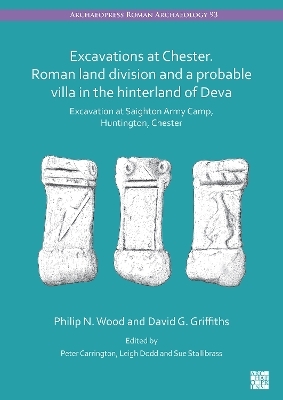
Excavations at Chester. Roman Land Division and a Probable Villa in the Hinterland of Deva
Archaeopress (Verlag)
978-1-80327-227-6 (ISBN)
Excavations at Chester. Roman land division and a probable villa in the hinterland of Deva reports on excavations carried out by Northern Archaeological Associates (NAA) at Saighton Camp – a former British Army training camp – located to the south of the Roman legionary fortress of Chester (Deva Victrix) which revealed important and extensive Roman period remains. Part of a high-status settlement of second- to fourth-century date, together with a regular field system laid out over more than 20 hectares, were encountered.
The excavated settlement appears to be an ancillary area to a much larger site, the centre of which lies to the south and is believed to be a villa. This is the closest such site to Chester, and villas are notably rare in the region. The field system was probably laid out by the legion at Deva as part of the prata legionis, agricultural lands they controlled around the fortress.
Leigh Dodd has worked in the commercial sector of archaeology since the early 1990s. During this time he has excavated a wide range of sites including many of the Roman and post-medieval periods, several of which have been published in regional and international journals, and he has written many finds reports for a broad range of clients. He is also a Member of the Chartered Institute for Archaeologists.
Chapter 1: Introduction ;
Summary ;
Archaeological background: Roman Chester, Cheshire and beyond – P.N. Wood ;
Chapter 2: Results of the Excavations ;
Introduction ;
Field system – P.N. Wood and C. Pole ;
Excavated settlement – P.N. Wood ;
Chapter 3: Finds and Environmental Remains ;
Building materials – C. Antink and D.G. Griffiths ;
Hand-made pottery – C.G. Cumberpatch ;
The Romano-British pottery – D.G. Griffiths, with contributions by L. Dodd ;
The small finds ;
Metalworking debris – L.F. Gardiner ;
Glass bead – E.M. Foulds ;
Antler knife handle – E.M. Foulds ;
Roman coin – R.J. Brickstock ;
Querns – R.J. Cruse (lithology by T Morse) ;
Animal bone – A. Trentacoste, A. Zochowski and E. Wright ;
Palaeobotanical and charcoal assessment – L.F. Gardiner ;
Chapter 4: Discussion – P.N. Wood ;
The excavated evidence ;
Chronology ;
Site functions, economy and place in the fortress’ hinterland ;
Roman field system and landscape continuity ;
Excavated structures ;
Religious observance on the settlement ;
Conclusions ;
Bibliography
| Erscheinungsdatum | 28.11.2022 |
|---|---|
| Zusatzinfo | Illustrations, unspecified |
| Verlagsort | Oxford |
| Sprache | englisch |
| Maße | 203 x 290 mm |
| Gewicht | 4940 g |
| Themenwelt | Geisteswissenschaften ► Archäologie |
| Geschichte ► Allgemeine Geschichte ► Vor- und Frühgeschichte | |
| Geschichte ► Allgemeine Geschichte ► Altertum / Antike | |
| Geisteswissenschaften ► Geschichte ► Regional- / Ländergeschichte | |
| ISBN-10 | 1-80327-227-9 / 1803272279 |
| ISBN-13 | 978-1-80327-227-6 / 9781803272276 |
| Zustand | Neuware |
| Haben Sie eine Frage zum Produkt? |
aus dem Bereich


